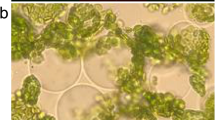Abstract
Ion channels in the plasma membrane of root cell protoplasts of Plantago media L. were studied with the patch clamp technique in the cell-attached patch and outside-out patch configuration. An outward rectifying potassium channel was dominantly present in the plasma membrane. It appears responsible for the diffusional part, dominated by the K+ diffusion potential, of the cell membrane potential, in vivo. This channel is activated at potentials near to and more positive than the K+ diffusion potential. The dependence of this ion channel on K+ activity and voltage has been characterized. The current-voltage relationships of the open channel at various K+ concentrations are described by a four-state model. The membrane potential of intact protoplasts appears either dominated by the K+ diffusion potential, the protoplast is then said to be in the K state, or by the pump potential generated by the plasma membrane-bound proton pump/H+ ATPase, the P state. An experimental procedure is described to determine in cell-attached patch mode the state of the protoplast, either K or P state.
Similar content being viewed by others
References
Beilby, M.J. 1986. Factors controlling the K+ conductance in Chara. J. Membrane Biol. 93:187–193
Bertl, A. 1989. Current-voltage relationships of a sodium-sensitive potassium channel in the tonoplast of Chara corallina. J. Membrane Biol. 109:9–19
Bertl, A., Gradmann, D. 1987. Current voltage relationships of potassium channels in the plasmalemma of Acetabularia. J. Membrane Biol. 99:41–49
Bisson, M.A., Walker, N.A. 1982. Transitions between modes of behavior (states) of the charophyte plasmalemma. In: Plasmalemma and Tonoplast: Their Functions in the Plant Cell. D. Marmé, E. Marrè and R. Hertel, editors. pp. 35–40. Elsevier Biomedical Press B.V., Amsterdam
Bush, D.S., Hedrich, R., Schroeder, J.I., Jones, R.L. 1988. Channel-mediated potassium flux in barley aleurone protoplasts. Planta 176:368–377
Caceci, M.S., Cacheris, W.P. 1984. Fitting curves to data: The simplex algorithm is the answer. Byte 5:340–362
Cruz-Mireles, R.M., Ortega-Blake, I. 1991. Effect of Na3VO4 on the P-state of Nitella translucens. Plant Physiol. 96:91–97
De Boer, A.H. 1985. The energy metabolism of excised Plantago media roots and its relation to the plasma membrane electrical potential difference. In: Xylem/Symplast Ion Exchange: Mechanism and Function in Salt-Tolerance and Growth. Ph.D. thesis. Rijks Universiteit Groningen, Groningen, The Netherlands
Debye, P., Hückel, E. 1923. Zur Theorie der Elektrolyte. II Das Grenz-gesetz für die elektrische Leitfähigkeit. Phys. Z. 24:305–325
Gradmann, D., Klieber, H.G., Hansen, U.P. 1987. Reaction kinetic parameters for ion transport from steady-state current-voltage curves. Biophys. J. 51:569–585
Gradmann, D., Bertl, A. 1989. Physiological control of membrane currents in plants. Plant Physiol. Biochem. 27:587–593
Hamill, O., Marty, A., Neher, E., Sakmann, B., Sigworth, F.J. 1981. Improved patch-clamp techniques for high-resolution current recording from cells and cell free membrane patches. Pfluegers Arch. 391:85–100
Hansen, U.P., Gradmann, D., Sanders, D., Slayman, C.L. 1981. Interpretation of current voltage relationships for “active” ion transport systems: I. Steady-state reaction-kinetic analysis of Class-I mechanisms. J. Membrane Biol. 63:165–190
Ince, C., Van Dissel, J.T., Diesselhoff, M.M.C. 1985. A teflon culture dish for high magnification microscopy and measurements in single cells. Pfluegers Arch. 403:240–244
Läuger, P., Stark, K. 1970. Kinetics of carrier mediated ion transport across lipid bilayer membranes. Biochim. Biophys. Acta 211:548–566
Maathuis, F.J.M., Prins, H.B.A. 1990. Electrophysiological membrane characteristics of the salt tolerant Plantago maritima and the salt sensitive Plantago media. Plant and Soil 123:233–238
Schroeder, J.I., Hedrich, R., Fernandez, J.M. 1984. Potassium-selective single channels in guard cell protoplasts of Vicia faba. Nature 312:361–362
Schroeder, J.I., Fang, H.H. 1991. Inward-rectifying potassium channels in guard cells provide a mechanism for low-affinity potassium uptake. Proc. Natl. Acad. Sci. USA 88:11583–11587
Vogelzang, S.A., Prins, H.B.A. 1992. Plasmalemma patch clamp experiments in plant root cells: procedure for fast isolation of protoplasts with minimal exposure to cell wall degrading enzymes. Protoplasma 171:104–109
Author information
Authors and Affiliations
Additional information
Institution paper no.: ECOTRANS publication no. 45.
Rights and permissions
About this article
Cite this article
Vogelzang, S.A., Prins, H.B.A. Patch clamp analysis of the dominant plasma membrane K+ channel in root cell protoplasts of Plantago media L. Its significance for the P and K state. J. Membarin Biol. 141, 113–122 (1994). https://doi.org/10.1007/BF00238245
Received:
Revised:
Issue Date:
DOI: https://doi.org/10.1007/BF00238245



